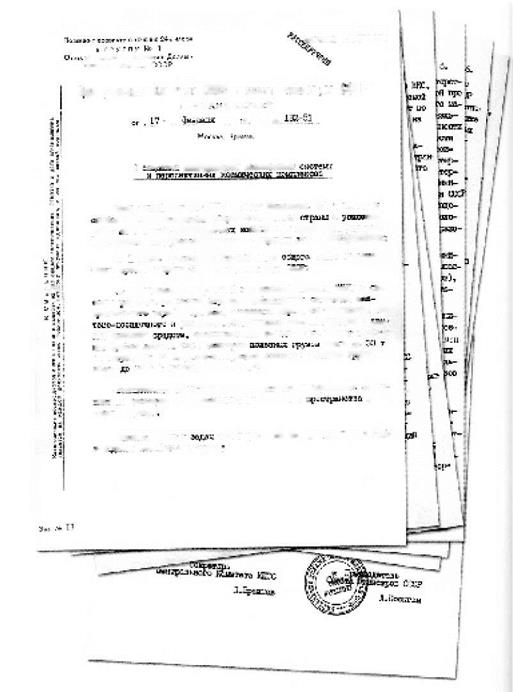When the idea to launch 6S on a shakedown flight emerged in 1985, the question also arose as to what payload to strap to the side of the rocket. An early suggestion was to fly an empty steel canister (4 m in diameter and 25 m long) which would remain attached to Energiya’s core stage and re-enter together with it. This would have required no modifications to the UKSS to service the payload. However, the Ministry of General Machine Building insisted on flying some kind of operational payload on 6SL. In the summer of 1985 the choice fell on an existing design for a nearly 100-ton spacecraft to test laser weapons in space.
The history of this project can be traced back to 1976, when NPO Energiya was tasked to start research on various types of “Star Wars’’ technology. Not coincidentally, this was around the same time that the Energiya-Buran program was initiated. The research, which essentially was a violation of the 1972 Soviet – American Anti-Ballistic Missile Treaty, covered three broad areas: anti-satellite missions, space-based anti-ballistic missile defense, and destruction of high-priority air, sea, and land-based targets using space-based assets. Early anti-satellite efforts at NPO Energiya focused on two types of Salyut-derived “battle stations’’, initially to be launched by Proton and later in the cargo bay of Buran. One of these (Skif or “Scythian”) (17F19) was to use laser weapons to destroy low-orbiting satellites, the other (Kaskad or “Cascade”) (17F111) missiles to destroy satellites in medium and geostationary orbits.
Because of the heavy workload at NPO Energiya, the Skif and Kaskad projects were transferred in 1981 to the Salyut Design Bureau (KB Salyut) in the Moscow suburb of Fili, which during that year had become a branch of NPO Energiya after having split off from the rival Chelomey design bureau. For the laser project KB Salyut came up with an entirely new design—namely, a 40 m long 95-ton object that was to be built at the Khrunichev factory and launched by Energiya. The engine section would be a modified Functional Cargo Block (FGB), the main part of the Transport Supply Ships (TKS) originally designed by KB Salyut to transport crews and cargo to Chelomey’s Almaz military space stations, but eventually flown as heavy cargo ships to the Salyut-6 and Salyut-7 space stations.
The ultimate goal was to develop a whole series of Skif battle stations with various types of laser installations. One of these was an infrared laser system called Stilet (“Stiletto”). Developed by NPO Astrofizika, this was intended to knock out the optical systems of enemy satellites, thereby rendering them useless. However, development of these laser systems ran into delays because it was difficult to keep them within the required mass limits. Spurred on by President Ronald Reagan’s announcement of the Strategic Defense Initiative (SDI) in March 1983, the Soviet military decided to develop an interim demonstration version (Skif-D) equipped with a much lighter, 1 MWt carbon dioxide gas laser built at the Kurchatov Institute of Atomic Energy that was already undergoing tests on a modified Ilyushin-76MD aircraft. The plan was to fly Skif-D1 with various auxiliary systems but without the laser itself and fly Skif-D2 with the laser system and use that to knock out small targets deployed from the vehicle itself. The main focus of the Soviet “Star Wars’’ program by now was not anti-missile defense, but to counter SDI by developing a capability to disable the planned American SDI battle stations. This would deprive the US of its missile shield and enable the Soviet Union to launch a pre-emptive nuclear strike.
When the opportunity arose to mount a payload on Energiya 6SL, Baklanov ordered KB Salyut in July 1985 to build a mock-up version of Skif-D called Skif-DM (“M” standing for maket or “dummy”). The initial idea was just to build a mock-up of Skif-D filled with sand or water and keep that attached to Energiya or separate it from the rocket for subsequent re-entry. The next suggestion was to place it into orbit for a week-long mission, requiring the inclusion of an FGB assist module and a set of batteries. Finally, Baklanov insisted on a month-long mission to demonstrate some of the capabilities of Skif-D, with the final order coming on 19 August 1985. The hope was to fly Skif-DM (serial nr. 18201) on Energiya 6SL in September 1986, followed by Skif-D1 (18101) in June 1987 and Skif-D2 (18301) in 1988.
In its final design, Skif-DM was actually quite similar to the Skif-D1 demonstration vehicle, equipped with various auxiliary systems needed to operate a space-based laser, but not carrying the laser itself (contrary to many rumors in the West). The spacecraft was 36.9 m long, had a maximum diameter of 4.1 m and a mass of 77 tons. It consisted of a modified FGB section called FSB (Functional Service Block) and a Payload Module (TsM). The FSB was an available FGB section that had originally been planned to act as a space tug for a now canceled Mir module. It contained all the housekeeping equipment that could not be exposed to the vacuum of space and the engines needed for orbit insertion and attitude control. Mounted on the outside of the FSB were two solar panels. Skif’s FSB section was protected during the early stages of launch by a newly developed fiberglass payload shroud, which had to be jettisoned such that it would not hit Skif or the Energiya rocket.
The Payload Module was made up of a Gas Compartment (ORT), an Energy Compartment (OE), and a Special Equipment Compartment (OSA). In the final Skif-D design, the ORT was to house canisters with carbon dioxide to feed the laser, but in order not to arouse suspicion in the West, the canisters on Skif-DM (42 in all) were filled with xenon and krypton instead. The gases would be released into space and their interaction with the ionosphere could then be explained as a geophysical experiment. The OE was intended to carry two 1.2 watt electric turbogenerators, but since these would not be ready in time for the Skif-DM launch, this compartment was virtually empty. It did have a special exhaust system using gas vanes that would make it possible to release the xenon and krypton without imparting momentum to the spacecraft. The OSA did not have the carbon dioxide laser system, but did carry the acquisition, tracking, and pointing mechanisms needed to find targets and keep the laser pointed at them. This included a radar system for rough pointing and a small low-energy laser for fine pointing. The pointing mechanism was supposed to be mounted on a rotatable platform, but this was not ready for Skif-DM either. The data were processed by an Argon-16 computer similar to the one flown on the Mir space station.
In order to calibrate the sensors of the acquisition, tracking, and pointing system, Skif-DM carried 34 small targets (both inflatable balloons and angled reflectors) that would be released from two small modules almost resembling strap-on boosters attached to either side of the OSA. Fourteen of the inflatable balloons would release barium to simulate the exhaust trails from ballistic missiles and spacecraft. Officially, the deployment of the targets would be explained as a test of an experimental approach and docking system and the release of the barium as a geophysical experiment to study the interaction of plasma with the ionosphere.
Skif-DM also carried four technological and six geophysical experiments not directly related to Skif-D. The technological experiments (VP-1, VP-2, VP-3, and VP-11) were aimed at studying techniques for launching and operating large-size spacecraft. One set of geophysical experiments (Mirazh-1, Mirazh-2, and Mirazh-3) was designed to study the interaction of rocket combustion products with the upper atmosphere and ionosphere during launch and deorbit. Another set (GF-1/1, GF-1/2, and GF-1/3) studied the interaction of artificial gas and plasma formations with ionospheric plasma during operation of the FSB engines. Observations of the geophysical experiments were to be conducted from the ground, sea, and air.
Since the Payload Module contained relatively few operating instruments, temperatures inside could drop to unacceptably low levels, which is why the outer surface was painted black to ensure maximum absorption of solar heat. Painted on the side was the name Polyus (“Pole”), which is apparently how the vehicle was supposed to be announced to the world after launch. After the Payload Module’s
The Skif-DM/Polyus spacecraft: 1, FSB engine section; 2, FSB instrument and payload section; 3, Gas Compartment; 4, Energy Compartment; 5, Special Equipment Compartment; 6, payload shroud; 7, FSB solar panels; 8, gas canisters; 9, momentless exhaust system; 10, acquisition, tracking, and pointing system; 11, bottom view of Skif-DM showing the two modules stowed full with targets (source: Zemlya i vselennaya).
arrival at the Baykonur cosmodrome, KB Salyut engineers also painted the name “Mir-2” on its front section. This was part of a cover story for the mission in which the TASS news agency would describe it as a prototype space station module. There was even some truth to it, because plans at the time did indeed call for the Mir-2 space station to be made up of massive modules to be launched by Energiya. There were two competing designs for such modules within NPO Energiya, one put forward by the central design bureau in Kaliningrad and the other by the KB Salyut branch in Fili. With the latter based on the Skif-D/FSB design, the Skif-DM mission would have provided valuable data for the KB Salyut space station design had it ever been selected.














